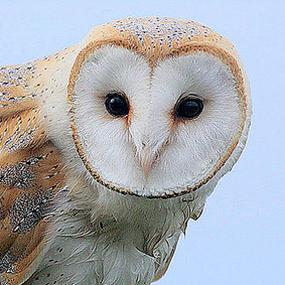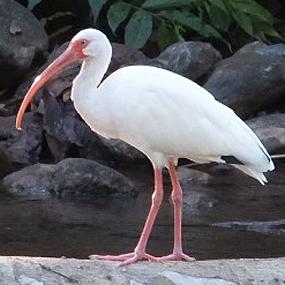For "Winged Wednesday":
Yellow-breasted Chat, Buffoon of the Briar Patch"Described as an “aberrant warbler” by Roger Tory Peterson, the Yellow-breasted Chat is an odd example of a North American wood warbler – twice as large as most, with a stout bill more like a vireo’s. Debate continues about whether the chat is in fact a warbler or something else altogether.
Whatever it may be, its song, sometimes heard at night, is as distinctive as the bird itself: a bizarre collection of cackles, clucks, whistles, and hoots. P.A. Taverner, a Canadian ornithologist, describes the bird perfectly:
“With his stealthy elusiveness, wild outpourings of song and fund of vituperation, the Chat is a droll imp . . . He is full of life and boiling over with animation. It bubbles out of his throat in all manner of indescribable sounds. He laughs dryly, gurgles derisively, whistles triumphantly, chatters provokingly, and chuckles complacently, all in one breath.”
Read more about this odd bird >>
______
White Ibis of the Trinity River Dallas, Texas
"Look a White Ibis in the eye! Following the White Ibis flocks of the Trinity River from roost to their feeding areas in a large swamp in the Great Trinity Forest Dallas, Texas. June 2013"
and see a Purple Sandpiper with a flock of Ruddy Turnstones. Short, but a beautiful recording."
______
Rat Poison - Bird-safe Alternatives
Rat poison hurts birds of prey, too.

"When birds of prey die from rodenticides, it’s a double whammy, because there are fewer birds to control the rodents. This Barn Owl – and the members of its family – can consume about 1,300 rats per year! Fortunately, there are safe and humane alternatives to rat poison, like electric traps.
EPA told the makers of d-CON, and others, to re-formulate their rat-poison products in protective bait stations and stop selling the acutely toxic “second generation” anti-coagulants on the retail market. Most complied, but d-CON didn’t. I still see these products on the shelves at my local hardware store." Learn more at: http://birdnote.org/show/rat-poison-bird-safe-alternatives
______
Christmas Bird Count

About the Christmas Bird Count
"The 114th Annual Audubon Christmas Bird Count will take place Dec 14, 2013 to January 5, 2014. The longest running Citizen Science survey in the world, Christmas Bird Count provides critical data on population trends. Tens of thousands of participants know that it is also a lot of fun. Data from the over 2,300 circles are entered after the count and become available to query under the Data & Research link." Read more
2012-2013 Texas Christmas Bird Counts
______
BirdNote: Cassowaries to Millerbirds!
Upcoming Shows
Southern Cassowary SUNDAY Encounter with a Cassowary by Bob Sundstrom LISTEN NOW ►
American White Pelicans MONDAY Pelicans Go Fishing by Dennis Paulson LISTEN NOW ►
White Ibis TUESDAY Costa Rica - The Land Is Pulsing with Life by Chris Peterson LISTEN NOW ►
Purple Sandpiper WEDNESDAY Strange Twins -- Purple and Rock Sandpipers by Bob Sundstrom LISTEN NOW ►
Nihoa Millerbird THURSDAY Millerbirds Thrive On Laysan Island Featuring George Wallace, American Bird Conservancy LISTEN NOW ►
FRIDAY Christmas Bird Count For Kids Featuring Tom Rusert LISTEN NOW ►
Long-tailed Duck SATURDAY The Music Of Long-tailed Ducks by Bob Sundstrom LISTEN NOW ►
______
On This Day:
Wetherill and Mason discover Mesa Verde, Dec 18, 1888:
"While searching for stray cattle in the isolated canyons of southwest Colorado, Richard Wetherill and his brother-in-law stumble upon the magnificent ancient Indians ruins of Mesa Verde.
The Wetherill family started ranching in the rugged southwest lands of Colorado in 1881, and Richard and his brothers often explored the canyons and mesas for Indian ruins. Once, while looking up the mouth of Cliff Canyon, Wetherill was approached by a Ute Indian named Acowitz who reportedly told him, "Deep in that canyon and near its head are many houses of the old people-the Ancient Ones. One of those houses, high, high in the rocks, is bigger than all the others. Utes never go there, it is a sacred place." Wetherill was intrigued, but his ranching duties kept him from exploring the canyon further.
On December 18, 1888, Wetherill and his brother-in-law, Charles Mason, were searching for stray cattle on top of a broad mesa when a heavy snow began to fall. Fearing they might ride over a cliff in the blinding snow, they dismounted and were moving ahead on foot when they came to an overlook point. From across 
Wetherill and Mason had stumbled across the "houses, high, high in the rocks" that Acowitz had told them about. The ruins were once the home of the Anasazi (the Indian term for "ancient ones") people. Subsequent archaeological studies showed that the Cliff Palace, as it became known, was built during the 13th century, when the Anasazi moved from the top of the mesas onto ledges and caves along the canyon walls, presumably to better defend themselves against invaders. Eventually a prolonged drought that started around 1275 forced the Anasazi to abandon their magnificent cliff dwellings.
In the years following the discovery, Wetherill collected thousands of artifacts from the Cliff Palace and other area ruins. Most of Wetherill's artifacts ended up in museums, where they could be studied by professional archaeologists and viewed by the public. The same cannot be said of the many other priceless artifacts that were stolen by visitors over the years. In order to protect the site from further looting and degradation, the Congress created Mesa Verde National Park in 1906."
______
Yesterday:
Really, I don't know where the day went. Some 

.jpg)
























2 comments:
You sure work harder and accomplish more in a day than I do, and I just don't know where you get your energy!
Hi Gypsy,
Please note that I said I did SOME cleaning, that doesn't say much! Housework is not my forte.
Happy Trails, Penny
Post a Comment